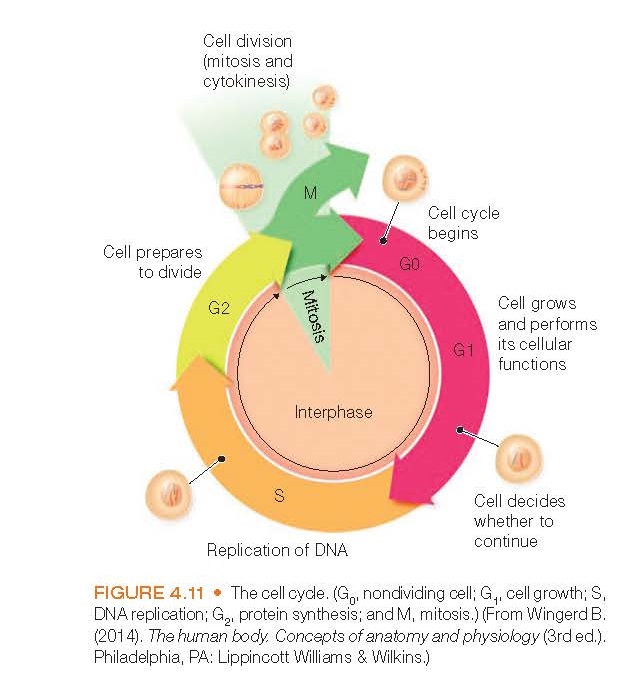The Cell Cycle and Cell Division.
The life cycle of a cell is called
the cell cycle. It is usually divided into five phases:
1. G0
2. G1
3. S
4. G2
5. M (Fig. 4.11)
G0 is the stage when the
cell may leave the cell cycle and either
remain in a state of inactivity or reenter the cell cycle at another time. G1 is the stage during which
the cell begins to prepare for
mitosis through DNA and protein synthesis and an increase in organelle and
cytoskeletal elements. The S phase is the synthesis phase, during which DNA
replication occurs and the centrioles begin to replicate. G2 is the premitotic
phase and is similar to G1 in terms of RNA activity and protein synthesis. The M phase is the phase
during which cell mitosis occurs. Tissues may be composed primarily of
quiescent cells in G0, but most tissues contain a combination of
cells that are continuously moving through the cell cycle and quiescent cells
that occasionally enter the cell cycle. Nondividing cells, such as neurons and skeletal and cardiac
muscle cells, have left the cell
cycle and are not capable of mitotic division in postnatal life.
Cell division, or mitosis, is the
process during which a parent cell
divides and each daughter cell receives a chromosomal karyotype identical to
the parent cell. Cell division gives the body a means of replacing cells that
have a limited life span such as skin and blood cells, increasing tissue mass
during periods of growth, and providing for tissue repair and wound healing.
Mitosis is a
dynamic and continuous
process. It is divided into four stages prophase, metaphase,
anaphase, and telophase (Fig. 4.12). The phase during which the cell is not
undergoing division is called interphase. During prophase, the
chromosomes become visible because of increased coiling of the DNA, the two
centrioles replicate, and a pair moves to each side of the cell.
Simultaneously, the microtubules of the mitotic spindle appear between the two
pairs of centrioles. Later in prophase, the nuclear envelope and nucleolus
disappear. Metaphase involves the organization of the chromosome pairs
in the midline of the cell and the formation of a mitotic spindle composed of
microtubules. Anaphase is the period during which separation of the
chromosome pairs occurs, with the microtubules pulling one member of each pair
of 46 chromosomes toward the opposite cell pole. Cell division or cytokinesis
is completed after telophase, the stage during which the mitotic
spindle vanishes and a new nuclear membrane develops and encloses each complete
set of chromosomes.
Cell division is controlled by
changes in the concentrations and activity of three major groups of
intracellular proteins:
1.
Cyclins
2.
Cyclin-dependent
kinases (CDKs)
3.
Anaphase-promoting
complex
The central components of the cell
cycle control system are the CDKs, whose activity depends on their association
with the regulatory units called cyclins. Oscillations in the activity
of the various CDKs lead to initiation of the different phases of the cell
cycle. Cell division is also controlled by several external factors, including
the presence of cytokines, various growth factors, or even adhesion factors
when the cell is associated with
other cells in a tissue.






